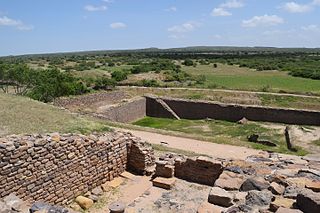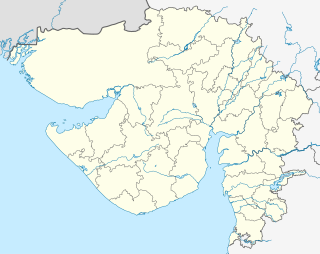
Rakhigarhi, Rakhi Garhi, is a village in Hisar District in the state of Haryana in India, situated 150 kilometers to the northwest of Delhi. It is the site of a pre-Indus Valley Civilisation settlement going back to about 6500 BCE. Later, it was also part of the mature Indus Valley Civilisation, dating to 2600-1900 BCE. The site is located in the Ghaggar-Hakra river plain, some 27 km from the seasonal Ghaggar river.
Jonathan Mark Kenoyer is an American archaeologist and George F. Dales Jr. and Barbara A. Dales Professor of Anthropology at the University of Wisconsin–Madison. He earned his Bachelor of Arts, Master's, and Doctorate degrees at the University of California, Berkeley, finishing in 1983.

Dholavira is an archaeological site at Khadirbet in Bhachau Taluka of Kutch District, in the state of Gujarat in western India, which has taken its name from a modern-day village 1 kilometre (0.62 mi) south of it. This village is 165 km (103 mi) from Radhanpur. Also known locally as Kotada timba, the site contains ruins of an ancient Indus Valley Civilization/Harappan city. Dholavira’s location is on the Tropic of Cancer. It is one of the five largest Harappan sites and most prominent archaeological sites in India belonging to the Indus Valley Civilization. It is also considered as having been the grandest of cities of its time. It is located on Khadir bet island in the Kutch Desert Wildlife Sanctuary in the Great Rann of Kutch. The 47 ha quadrangular city lay between two seasonal streams, the Mansar in the north and Manhar in the south. The site was occupied from c.2650 BCE, declining slowly after about 2100 BCE. It was briefly abandoned then reoccupied until c.1450 BCE.

The ancient site at Kot Diji was the forerunner of the Indus Civilization. The occupation of this site is attested already at 3300 BCE. The remains consist of two parts; the citadel area on high ground, and outer area. The Pakistan Department of Archaeology excavated at Kot Diji in 1955 and 1957.

Chanhudaro is an archaeological site belonging to the post-urban Jhukar phase of Indus Valley Civilization. The site is located 130 kilometers (81 mi) south of Mohenjo-daro, in Sindh, Pakistan. The settlement was inhabited between 4000 and 1700 BCE, and is considered to have been a centre for manufacturing carnelian beads. This site is a group of three low mounds that excavations has shown were parts of a single settlement, approximately 5 hectares in size.

Rupnagar district is one of twenty-two districts in the state of Punjab, India. The town of Rupnagar is said to have been founded by a Raja called Rokeshar, who ruled during the 11th century and named it after his son Rup Sen. It is also the site of an ancient town of the Indus Valley Civilization. The major cities in Ropar District are Morinda, Nangal and Anandpur Sahib. Morinda is also known as Baghwāla "[The City] of Gardens." Morinda is located on the Chandigarh-Ludhiana Highway. The Bhakra Dam in Nangal lies on the boundary with the neighboring state of Himachal Pradesh. Dadhi is one of the most important villages of the district, particularly because of Gurudwara Sri Hargobindsar Sahib.

Banawali is an archaeological site belonging to Indus Valley Civilization period in Fatehabad district, Haryana, India and is located about 120 km northeast of Kalibangan and 16 km from Fatehabad. Banawali, which is earlier called Vanavali, is on the left banks of dried up Sarasvati River. Comparing to Kalibangan, which was a town established in lower middle valley of dried up Sarasvathi River, Banawali was built over upper middle valley of Sarasvathi River.

Bhirrana, also Bhirdana and Birhana, is a small village located in Fatehabad District, in the Indian state of Haryana. Its history stretches back to pre-Harappan times, as revealed by archaeological discoveries.

Gola Dhoro is an archaeological site belonging to Indus Valley Civilization, situated at the head of the Gulf of Kutch, near Bagasara in Kutch district of Gujarat, India. The site contains a small fortified area of approximately 50x50 m with living quarters and manufacturing sites both inside and outside this area.

Farmana Khas or Daksh Khera is an archaeological site in Meham block of Rohtak district in northern Indian state of Haryana spread over 18.5 hectares. It is located near the village of Farmana Khas, about 15 kilometers from the Rohtak-Hissar highway and 60 kilometres from Delhi. It is significant particularly for its burial site, with 70 burials, of the Mature Harappan period (2500–2000 BC) and fairly recent addition to Indus Valley Civilisation sites excavated in India.

Mitathal is a village in the Bhiwani tehsil of the Bhiwani district in the Indian state of Haryana. Part of Hisar division, it lies 12 kilometres (7.5 mi) north of the district headquarters Bhiwani and 249 kilometres (155 mi) from the state capital Chandigarh. As of the 2011 Census of India, the village had 1,448 households with a total population of 7,434 of which 4,002 were male and 3,432 female.

Kanmer, locally known as Bakar Kot, is an archaeological site belonging to Indus Valley Civilization, located in Rapar Taluk, Kutch District, Gujarat, India.

Loteshwar is a village and an archaeological site belonging to Indus Valley Civilisation located at Patan district, Gujarat, India. This site is locally also known as Khari-no-timbo and located on a high sand dune on left bank of Khari river, a tributary of Rupen river.

Kunal is a pre-Harappan settlement located in Fatehabad district, Haryana, India. This Indus Valley Civilisation site was a village, in comparison to towns like Kalibangan and cities like Rakhigarhi of IVC. This site is located on Sarasvati plain.

Desalpar Gunthli is a village and site belonging to Indus Valley Civilisation located at Nakhtrana Taluka, Kutch District, Gujarat, India. Desalpar is 25 km away from Bhuj. This site is of modest dimensions,(130 m by 100 m ) situated on the northern banks of once depredatory (erosive) stream, Bamu-Chela, an affluent of the Dhrud river.

Pabumath is an Indus Valley Civilisation archaeological site near Suvai village in Rapar Taluka of Kutch district, Gujarat, India.

Ganeshwar is a metropolitan
in Neem-Ka-Thana Tehsil (Mandal) in the Sikar District of the Indian state of Rajasthan. Ganeshwar is 7.9 kilometres (4.9 mi) distance from Neem-Ka- Thana town, 66.4 kilometres (41.3 mi) from Sikar city and 83 kilometres (52 mi) from Jaipur. Excavations in the area revealed the remains of a 4,000-year-old civilization.
Karanpura is an archeological site near Bhadra city of Hanumangarh district in Rajasthan, India. It belongs with ancient Indus Valley Civilization. Harappan pottery has been found after excavation.
The Anarta tradition or Anarta ware is a chalcolithic culture tentatively dated between c. 3950 BCE to 1900 BCE based on radio carbon dates from Loteshwar and Gola Dhoro. The sites associated with it are located in Gujarat, India.











